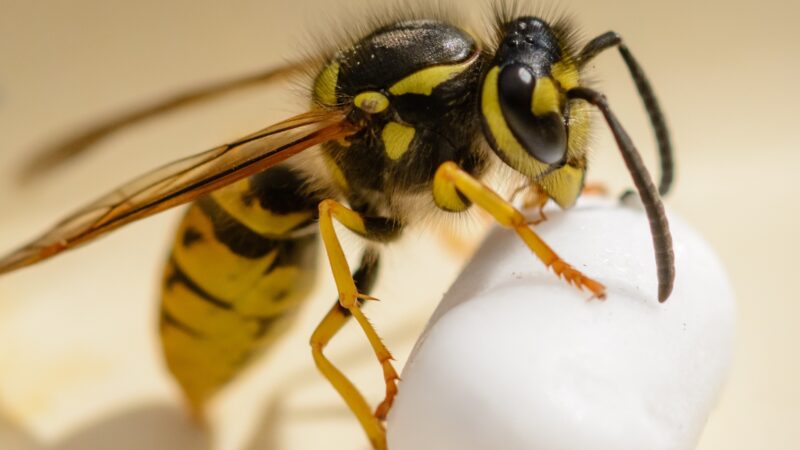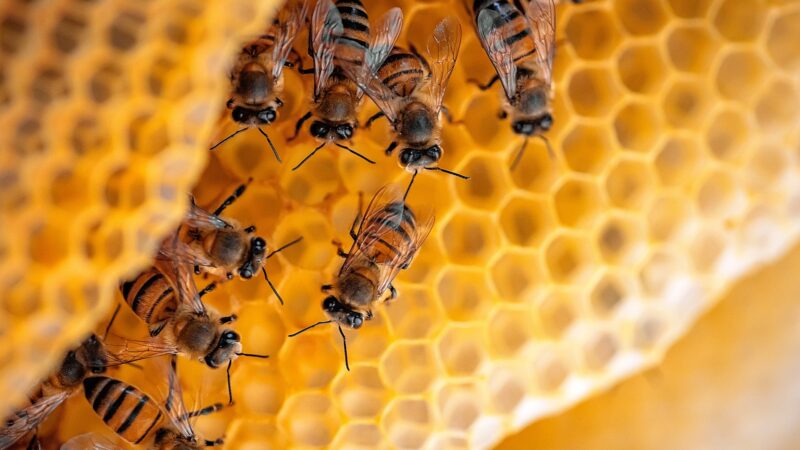Although wasps and bees are typically not aggressive, they may sting if they feel their nest is threatened by predators or disturbed by humans and other animals. If you find that poses a threat to your safety, you can eliminate these insects using homemade sprays made from common ingredients.
To make a homemade spray that will work on both wasp and be, you can use peppermint oil spray, soap spray, essential oils spray, mixed ingredients spray, lemon extract spray, spice spray, and plant extracts spray. Simply mix the proper amount of ingredients into the water before putting it inside a spray bottle, Shake well, and it’s ready to go!
This article details everything you need to know about useful homemade wasp and bee sprays, how to identify and differentiate wasps and bees, and other interesting information. Read further for more!
How to Make a Homemade Bee and Wasp Trap?
Step 1: Mark a line around the neck of a 2-liter soda bottle using a permanent marker. If you want the line to be straight, tie a rubber band or string around the bottle to use as a guide when marking.
Step 2: Cut the bottle on the marked line. Use a box cutter, knife, scissors, or other applicable, sharp cutting tools.
Step 3: Add bait to the trap. You can use jam, fruit juice, sugar water, and other sweet sugary liquids. Make sure not to use honey as this will attract honeybees, which are essential pollinators.
Step 4: Remove the cap of the bottle, flip it upside down, then place it onto the other half of the bottle where you placed the bait.
Step 5: Place it outdoors where you observe bee or wasp activity. You can also choose to hang the trap in a tree and other structures.
Step 6: Once you have successfully captured bees or wasps, dispose of them immediately, then reapply the bait every week if you wish to keep getting rid of them.
Lemon Extract
A powerful wasp repellent and insecticide is lemon extract. 3 tablespoons of lemon essence and 1 cup of water should be combined for the greatest results.
For a quick, simple, and effective insecticide, combine this solution with a plastic spray bottle. Lower the amount of lemon essence by half if you want to make a powerful repellent. Wasps should be killed if sprayed with the recommended dosage, and treating a nest should keep them away.
Liquid Dish Soap
Water should be added to a plastic sprayer about halfway. After that, stir gently while adding 1/4 cup of liquid dish soap. Allow any suds that rise to the surface to settle.
By allowing water to enter breathing tubes known as spiracles, dish soap kills wasps. The wasps soon drown when water gets inside these breathing passages.
Mixed Ingredients Spray
You will need 2 cups of apple cider vinegar, 2 cups of sugar, and 1 cup of warm water to make this trap. This mixture should be well blended until the sugar is completely dissolved.
Next, add roughly a quarter cup of dish soap, and stir until it is completely dissolved. Make sure no bubbles form before filling up a spray bottle.
Peppermint Oil
Peppermint oil can be combined with 4 cups of water to make a potent wasp repellant. Simply combine the two ingredients in a small dish. Use cautious when pouring this mixture because essential oils can irritate skin when they are not diluted.
Put this mixture in a spray bottle when it has been combined. Be careful not to get the spray’s mist in your eyes when you spray the area you wish to keep wasps away from. For maximum effectiveness, reapply this solution about once per week.
Wasp Repellent Plants
Some plants have incredibly potent wasp and insect repellant properties. One of the finest all-natural ways to defend your home against wasps and other annoyance insects is to plant these plants in your garden, backyard, or lawn.
- Sage
- Rosemary
- Thyme
- Fennel
- Wormwood
- Eucalyptus
- Citronella
- Spearmint
Boil the leaves of wormwood, eucalyptus, thyme, spearmint, or citronella in 4 pints of water for 30 minutes. Add 1 teaspoon of Castile powder, then place it inside a spray bottle.
Essential Oils Spray
Mix 1 teaspoon of lemongrass oil, 1 teaspoon of clove oil, 1 teaspoon of geranium essential oil, and 6 cups of water, then put it inside a spray bottle.
How to Get Rid of Bees and Wasps?
- Sanitize your area by disposing of any dropped or decaying fruit and other garbage. Close recycling bins since they may contain food scraps or liquid that can attract bees and wasps.
- Seal and caulk cracks inside walls and crevices of buildings, as these places can serve as nesting sites for both bees and wasps.
- Paint or varnish any wood surfaces that are exposed. You can also fill them with caulking, putty, or wood plugs.
- For bees and wasps that nest underground or in burrows, apply a layer of mulch onto your lawn or yard. Standard bark mulch works wonders, but make sure you apply a thick layer of it. You can also thicken the grass and other vegetation by watering, fertilizing, and planting more grass.
- Grow plants that are effective at repelling bees and wasps, such as thyme, spearmint, citronella, wormwood, and eucalyptus. Flowering plants such as pennyroyals, geraniums, and marigolds can also work.
Wasps | Identification

Wasps generally do not bother people unless their nests become threatened or disturbed. They have barbless stingers, which allow them to sting multiple times. When treating their nests, it should be done during late evening or early in the morning when the insects are less active. Protective clothing should be worn to reduce the chances of being stung.
- Appearance: Slender-bodied insects that are black or brown with yellow markings, long legs, few hairs on their bodies, narrow waists, and biting mouthparts.
- Common Types: Yellowjackets, paper wasps, ground wasps, and mud daubers
- Average Size: ⅓ to 1 inch
- Lifespan: 12 to 22 days (workers); Up to 1 year (queens)
- Habitat: Ceilings, verandas, trees and shrubs, attics, burrows and holes near food sources, and walls.
- Diet: Nectar, honeydew, decaying fruit, and other sources of sugar as well as insects
- Threat: Wasps are a threat to public health. Allergic reactions to wasp stings account for 225,000 emergency room cases, with about 50 deaths, annually in the United States.
- Control: Wasp and hornet sprays, as well as insecticide dust found in retail stores, are effective products that can eliminate wasps easily. However, it is best to contact professional pest control services, as wasps can get quite aggressive.
Related: How to Get Rid of Wasps in the House? | Information and Facts
Bees | Identification

Bee pollination can make about 15 billion dollars of honey and other food products in the United States annually, making them highly beneficial insects to humans. Contacting a local beekeeper is the first thing to do when finding an active colony as it is not advised to get rid of their nests unless they pose too big of a threat.
- Appearance: Thick-bodied insects that are brown or black with yellow bands, covered with dense hair, straw-like mouthparts, and large eyes.
- Common Types: Honey bees, carpenter bees, bumble bees, and killer bees
- Average Size: 0.08 to 1.6 inches
- Lifespan: 5 to 7 weeks (workers); Up to 5 years (queens)
- Habitat: Tree cavities, voids located in building walls, underground in deserted rodent nests, underneath objects found on the ground, and in compost piles
- Diet: Nectar and pollen
- Threat: Bees can become a nuisance if they establish their hives near homes and buildings, which increases the chances of being stung. Their sting can be life-threatening and severe if a person is allergic to their venom.
- Control: Seek a local beekeeper to relocate the nest for you. They can also be eliminated using ficam dust applied to the entrance of the nest.
Are Bees and Wasps Aggressive?
Bees and wasps only attack in defense of their colony against intruders and predators. Normally, both are not aggressive unless given a reason to be, which is why they must be ignored when you spot them. Africanized honeybees, known as killer bees, attack in groups and are easily agitated by slight motions, odors, or vibrations.
Wasps vs. Bees | Which Is More Dangerous?

Wasps are more dangerous than bees due to their barbless stings that allow them to sting more than once. Bees have barbed stings, which means they can only sting once, and the act of stinging is fatal to them since they are disemboweled as soon as they pull away from the stung area. Moreover, wasp stings generally cause more serious allergic reactions.
Related: What to Do With a Wasp Sting? | All You Need to Know!
How Can You Tell the Difference Between a Wasp Sting and a Bee Sting?
The main difference is that bees leave their stingers behind after stinging you. The stinger is a tiny, needle-like protrusion that is dark in color. Both wasp and bee settings will cause swelling, red or pink welt around the sting, and a white spot on the center. You will also feel an instant, sharp pain at the site of the sting.
List of Sources
Bessin, R. (2019). Controlling Nuisance Honey Bees. University of Kentucky Entomology.
Eaton, A. T. (2016). Controlling Wasps, Bees and Hornets Around Your Home. University of New Hampshire Cooperative Extension.
Hahn, J., Jesse, L., Liesch, P. (2020). Wasps and bees. University of Minnesota Extension.
Voeller. D., Nieh, J. Analysis of Honeybee Aggression. UC San Diego.
- Bed Bug Surge 2025: How to Detect, Prevent, and Safely Eliminate Infestations in Top U.S. Cities - June 18, 2025
- Asian Needle Ants Invade US Homes: 2025 Guide to Identification, Risks, and Effective Control - June 11, 2025
- New World Screwworm Alert: How US Livestock Owners Can Prevent Outbreaks and Protect Herds [Summer 2025 Update] - June 8, 2025
